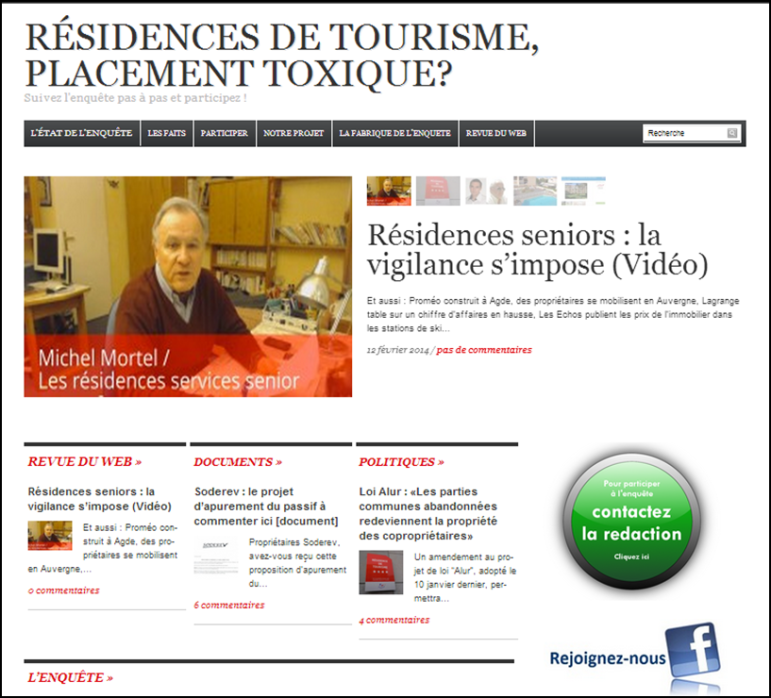

Investigative “Stakeholder Media” Emerge in U.S., France
The Marshall Project’s recent launch announcement confirmed that in coming years, many new investigative news media will resemble stakeholder media — vehicles that are aimed at specific communities of interest. This non-profit  organisation’s strategic goal is to become the central information hub for public insight into the criminal justice system. But within that general public, the first target will clearly be those directly concerned by the system. The stakeholder community for this venture is immense. It includes present and former prisoners, their families, law enforcement and auxiliaries, justice departments, the courts, lawyers — an audience of millions.
organisation’s strategic goal is to become the central information hub for public insight into the criminal justice system. But within that general public, the first target will clearly be those directly concerned by the system. The stakeholder community for this venture is immense. It includes present and former prisoners, their families, law enforcement and auxiliaries, justice departments, the courts, lawyers — an audience of millions.
We are seeing other such ventures. Last summer a team of young French journalists launched a web platform aimed at investigating scandals affecting vacation homes in France, Résidences de tourisme, placement toxique? (Houses of Tourism, Toxic Investment?). The project included successful crowd funding through a French site. One of its members had previously worked on a similar project aimed at investigating France’s social charges, designed by our team at INSEAD’s Stakeholder Media Project. 
In all these cases, a stakeholder community provides a core community of users and sources. That same community becomes the vector of influence for the reforms targeted and explored by the investigative project. This is not the Watergate-era mobilisation model of how investigative reporting achieves results, in which outraged, informed citizens demand better governance. It’s a coalition model, in which stakeholders move other stakeholders toward a shared goal. Both of these models were explored by David L. Protess, et al., in The Journalism of Outrage: Investigative Reporting and Agenda-Building in America (1992). Increasingly, the coalition model is emerging as a potent vehicle for both journalists and activists. (Anyone interested in how Greenpeace uses it can check out our article, “The Agenda-Setting Power of Stakeholder Media,” in the Fall 2013 California Management Review.)
The Marshall Project is aiming to be non-partisan. A necessary stance; current parties are studies in greed and failure. But there is a stated agenda: make criminal justice reform a national issue in the 2016 elections. The key ethic is transparency, not quite the same thing as the neutrality that became the hallmark of objectivity. It does not exclude promoting certain solutions. The Marshall Project says it will “highlight the work of advocacy groups on both the right and left.” This, too, is a signal that something has changed. Pro Publica, which follows a general public audience model, keeps activists at arm’s length.
The mainstream media (MSM) have lost their scruples about advocates; they need the content that NGOs and activists can provide. Before it was sold to Amazon, the Washington Post was running articles by Pro Publica and non-profit groups on its front pages. A mere decade ago investigative work was a staff function, because it was considered a strategic capability. Now it’s a luxury. No one media firm can cover all the significant publics that require deep information. Stakeholder media in their ensemble can. The Marshall Project, in effect, aims to be as expert about the criminal justice system as Greenpeace is about environmental issues.
The Marshall Project speaks of curating the torrent of information about the system. It remains to be seen which streams they are watching, and what they will collect, archive and make available, on what terms. Do lawyers get free access? Should they? The Marshall Project’s core team has considerable editorial experience, and its editorial vision is clear; the site says less about the business model. Will they give away their content, like Pro Publica? Personally, we don’t think value added content should be free, if only because independent reporters, who still do a lot of investigative work, can’t compete with that model. We sent these questions to Marshall Project founder and publisher Neil Barsky, and did not receive a response.
We have said since 2010 that stakeholder media, often driven by activist groups, are providing a growing share of MSM content. What no one in the news industry has done yet is to assemble a distribution network largely outside the MSM. Such networks are a key future asset in the stakeholder media world, which is why Greenpeace, Amnesty and others have built them. Will the Marshall Project build one? If so, will it be monetised? We’ll be watching the June launch closely.
 Mark Lee Hunter is senior research fellow and adjunct professor at INSEAD in Paris, and a veteran investigative trainer at his Story-Based Inquiry Associates. His six books include Le Journalisme d’investigation en France et aux Etats-Unis (the first cross-cultural study of investigative reporting methods) and Story-Based Inquiry: A Manual for Investigative Journalists.
Mark Lee Hunter is senior research fellow and adjunct professor at INSEAD in Paris, and a veteran investigative trainer at his Story-Based Inquiry Associates. His six books include Le Journalisme d’investigation en France et aux Etats-Unis (the first cross-cultural study of investigative reporting methods) and Story-Based Inquiry: A Manual for Investigative Journalists.









